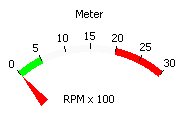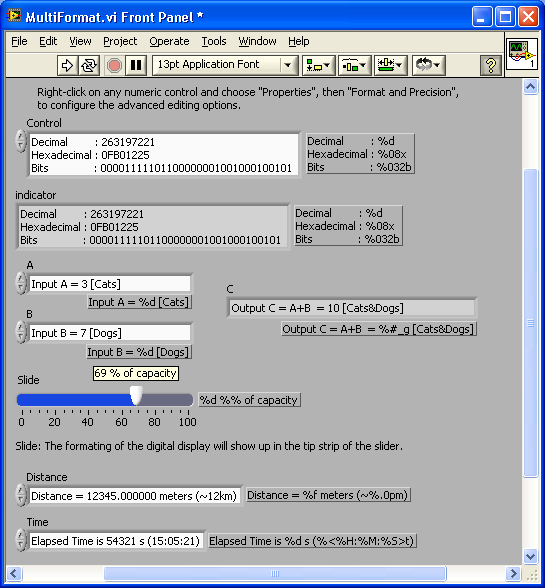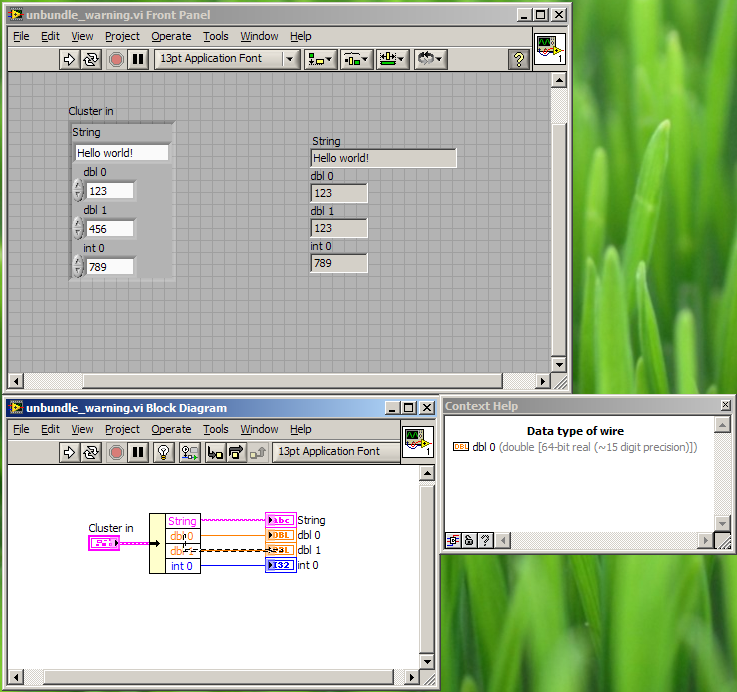-
Posts
2,767 -
Joined
-
Last visited
-
Days Won
17
Content Type
Profiles
Forums
Downloads
Gallery
Posts posted by Grampa_of_Oliva_n_Eden
-
-
QUOTE(Justin Goeres @ Sep 25 2007, 10:12 AM)
Sadly, no. That's due to lack of breakouts for the cable and lack of a scope.
What I can tell you that the handshaking definitely seems to be working, in the sense that the transmitter and the receiver each time out if the other isn't running. But I guess if there's a noise issue then the problem would be that the handshake hiccups every so often....
Well if you can't look then poke.
Put a good ground between the RTN lines of both ends.
I have seen this issue (bad grounds) affect Laptops (because they are isolated from ground via the battery) and USB-Serial adapters.
Another point:
You are reading ALL of the bytes at the port every time and NOT just a subset, CORRECT?
Ben
-
QUOTE(Justin Goeres @ Sep 25 2007, 09:54 AM)
...(switching to RTS/CTS handshaking seemed to help a little, but the error still occurred). ...Could you put a scope on the lines and make sure this is not a noise or bad ground issue?
Hardware handshaking should flag the transmitter to spot transmitting until CTS goes high again.
Ben
-
QUOTE(Justin Goeres @ Sep 25 2007, 09:00 AM)
...Perhaps NI should remove the documentation of the Add and Multiply nodes from the LabVIEW help? They're awfully basic, and the order of the inputs doesn't even matter!
When did that change? Are you sure? ( I swear I read the release notes!)
At one time the Advanced Course used to teach that the top input of a add node would be re-used while that was not the case with the bottom. So if you had a huge array that you needed to add an offset value to every value, the result would be put back in the same buffer used for the input terminal of the add node.
Is it any wonder why the buffer re-use rules are so hard to understand and apply.
Ben
-
-
QUOTE(watcher @ Sep 21 2007, 10:43 AM)
Hi,I'm a really beginner in LabView.
I didn't know a thing about it until three months ago, so there is a lot of things I don't know yet.
I had much experience working with Java, C++, PHP... and many other languages but not with LabView.
But I've been working hardly on it and I'm changing my mind.
So, I'm from Spain, I'm working with Labview and that's all.
If the question is very basic, you may want to try the http://forums.ni.com/ni/board?board.id=170' target="_blank">NI Fourums just because you can get faster answers there.
But you can post in both forums if you want. If you do, please let us know the post is duplicated so we don't try to naswer Q's that have alrady been answered.
If you have more challenging questions LAVA is definately the place to post.
So welcome to LAVA and I hope to see your answers.
Ben
-
QUOTE(Gabi1 @ Sep 21 2007, 07:38 AM)
Ben
-
QUOTE(Ben @ Sep 20 2007, 11:56 AM)
I don't use them either.I am just guessing based on the symptoms matching what I have seen using the waveform data types.
You are probably correct.
Ben
On a realted note....
Does the LAVA Tips and tricks mention that a WF data typed chart will plot points based on the t0 values? This allows non-periodic plotting.
And similarly, an empty Y array of the WF will be ignode, and also a "NaN" will break the plot line.
If not, you have been un-officially informed.
Ben
-
QUOTE(NormKirchner @ Sep 20 2007, 11:47 AM)
Nice find Ben. I haven't worked w/ the dynamic type much, but I have experienced the struggle w/ the waveform attributes once or twice. I suppose another option for him would be to just change the attribute rather than the property, no?I don't use them either.
I am just guessing based on the symptoms matching what I have seen using the waveform data types.
You are probably correct.
Ben
-
QUOTE(ecarrig @ Sep 20 2007, 11:33 AM)
Thanks for looking. I've included a few screenshots... one of the working toy example and one of the same code (i think ) that does not work in a flat sequence in my larger program. The function of this VI is to open an .lvm file, process it, and display the important data. Interestingly enough, I ran the program once with a bad .lvm file and the poperty node worked fine -- the graph read time [sec]. I am forced to conclude that somehow opening an .lvm file trumps redefining the property node, regardless of where the property node gets redefined.
) that does not work in a flat sequence in my larger program. The function of this VI is to open an .lvm file, process it, and display the important data. Interestingly enough, I ran the program once with a bad .lvm file and the poperty node worked fine -- the graph read time [sec]. I am forced to conclude that somehow opening an .lvm file trumps redefining the property node, regardless of where the property node gets redefined. thanks
Eamon
Right-click on the graph and make sure the graph is set to "ignore attributes".
Ben
-
-
The cyle is happening again.
We used to use mainframes with dumb terminals talking via serial ports.
PC came into use and the mainframes became more rare serving files and DB to the app's running on the PC.
My wife is evaluating how she will be upgrading all of the PC's used by the Library system she supports. Thin clients are looking good...
BUT
this means the files are now back on central machine.
Ben
-
QUOTE(Gary Rubin @ Sep 19 2007, 08:46 PM)
... you might be able to do much better by being careful with your threading ...Two points
1) The scenario I reported above, we did not get full utilizatio of all CPU until we had more than enough threads configured. In LV 8.0 they fixed a bug that kept the thread count low.
2) Artifical code sequencing ( excessive seq structures, preventing simultaneous execution) will prevent mutlithreading.
It SEEMS the code should look like a river delta, sepearting out into multiple streams to take full advantage of multiple cores.
Ben
-
QUOTE(beckerg @ Sep 20 2007, 06:39 AM)
Hi all wireworkers,Any ideas how to automatic search these kind of problems?
The VI is saved as LV8.5
Download File:post-1037-1190284217.vi
greetings
from a sunny Munich with just a few days left before Oktoberfest

I think that would show up in one of the VI Analyzer's tests.
Ben
-
QUOTE(eaolson @ Sep 19 2007, 05:41 PM)
Most of what I KNOW came from http://zone.ni.com/devzone/cda/tut/p/id/3558' target="_blank">this document.
Ben
-
QUOTE(yen @ Sep 19 2007, 03:25 PM)
Isn't that code encapsulated in a reentrant VI?Or, at the very least, in 8 file copies of the same VI?
Sorry to disapoint you YEN but no.

Its 8 cut-n-pastes to the diagram.*
Ben
* Disclaimer: For the most part, I code by the hour. The customers dictate how their money will be spent. As soon as they tested the 8-copy version, they said "Done!" If it makes any difference, it was very pretty code :thumbup: until I asked the engineer to to do the cut-n-paste.

Done disclaiming.
-
QUOTE(PaulG. @ Sep 19 2007, 01:29 PM)
Unless I'm misunderstand all the hype at NI, LV is quite capable NOW of performing as well if not better than that "other language", especially in RT applications. And in my own experience I've gotten deterministic data without RT, with most of the limitations in performance coming from limitations in the Windows environment.Yes good point Paul.
The area of performance that LV is pushing now is the raw number crunching teritory.
We hvae alrady seen this performance jump in one of our apps that did a bunch of FFT's from multiple microphones at the same time. The initial app swamped the CPU of the first machine we ran it on. I had the engineer implement parallel code for each microphone's data and the CPU was still swamped. We advised the customer that the biggest bang-for-the-buck would be to get a more powerful machine rather than pay us to try and squeeze some of the fat out of the app.
So after deploying the app to a new machine with four hyperthreading cores and adjusting the "threadconfig" so that we were using (?) 32 threads, we observed about a 40% utilization on all of the CPU's.
We have not anymore comments about performance from that customer.
I have to comment on one slight draw-back. THe diagram looks a little funny with exactly the same code duplicated side by side eight times. At first glance you could say "That should be done in a loop." NOT!
Ben
-
QUOTE(ned @ Sep 19 2007, 12:55 PM)
... What other value, other than the actual value of N, could possibly be a reasonable value on that wire?If you wire a constant "5" to the N form outside and also wire two arrays that are auto-indexed and one of the arrays has four elements and the other has three,
the inside N wire wire read "3" and NOT the "5" wired to the outside.
Ben
-
-
QUOTE(Jim Kring @ Sep 19 2007, 09:56 AM)
Hi All,I've written a new article, titled: http://thinkinging.com/2007/09/19/labview-and-the-multicore-crisis/' target="_blank">LabVIEW and the Multicore Crisis. (Don't worry, there's no crisis for LabVIEW developers.)
I hope you enjoy it

-Jim
Nice article Jim.
What is REALLY cool about this is that sometime soon (maybe in my life-time) LabVIEW applications will be able to out perform application writtien in that other language.
:thumbup:
Ben
-
QUOTE(rolfk @ Sep 19 2007, 02:19 AM)
Well, such is life. Most things I found by accident, searching actively for something or through user groups/mouth of word/LAVA/Info-LabVIEW etc. and when then looking for them they were eventually somewhere in the printed or online docs, but it is simply to much material to read through completely.I have long ago resorted to work with what I know and try to learn new things by various opportunities and simply not let myself be bothered that there are still many golden eggs out there that I do not know about. If I would have a photographic memory I would simply scan all the documents in a matter of flipping through them and rely on that, but alas, I'll have to do with what I can.
Rolf Kalbermatter
Yes.
Funny how things go around in circles.
So this is where the Upgrade notes, if exhaustive would make for a wonderful read.
Imagine if they upgrade notes read like the readers digest version of our Tips and Tricks!
Still dreaming, stil hoping.
Ben
-
The below was received from my father and I have no idea were he got it from.
So let just call it "Author unknown"
FINALLY,
after going through a virus attack,losing a hard drive,
fighting off hackers, upgrading all my software,
installing fire-walls, receiving blank e-mails,
being threatened with beingcut-off by my email provider,
and, a host of other problemsnow</EM> it works exactly the way I want it to!
-
Mike Porter and I ran into an issue with trying to use VI servers across PC in LV 8.2.1.
We are still waitng for NI to clarify which ini tokens are now being used and what they mean.
Please see this thread "on the dark side"
http://forums.ni.com/ni/board/message?boar...0&jump=true
Ben
-
QUOTE(wevanarsdale @ Sep 18 2007, 02:03 PM)
Karthik: 1. Select the "Meter" control on the panel of the attached VI. 2. Select "Customize Control..." from the Edit menu. 3. Press the button on the toolbar to change to customize mode. 4. Import your grid pattern by selecting "Import Picture to Clipboard..." from the Edit menu. 5. Select the white background on the control and paste your grid. 6. Resize as necessary and save the control.http://lavag.org/old_files/monthly_09_2007/post-10-1190138454.png' target="_blank">

Best of luck,
Adding to above...
THe color ramp values and colors can be changed on the fly.
So do the customizing as outlined.
Hide the needle
Code up the ramp color changes
You are there!
Ben
-
Dennis Knutson is looking for something!
See the list on the NI forum at this URL
http://forums.ni.com/ni/board/message?boar...8&jump=true
Ben






Wiring the 'N' terminal inside a For Loop
in LabVIEW General
Posted
QUOTE(Justin Goeres @ Sep 25 2007, 12:57 PM)
Add some pointy spectacles to your avatar and you'll be restored in my book!
Seriously, I'm just piling on LV-Trivia as the oppertunity presents itself.
Ben